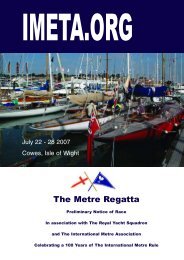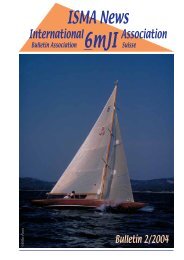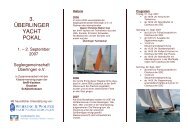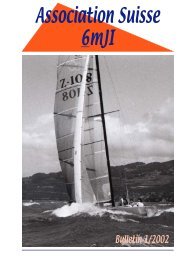CLASSIC SIX METRE NEWSLETTER
CLASSIC SIX METRE NEWSLETTER
CLASSIC SIX METRE NEWSLETTER
You also want an ePaper? Increase the reach of your titles
YUMPU automatically turns print PDFs into web optimized ePapers that Google loves.
their downwind jib. This meant sailing further off the wind and thus lengthening the distance<br />
to cover. This tactic enabled Cheta to close the distance and to arrive at the windward buoy<br />
almost at the same time as Aile IV.<br />
This manoeuvre was duly noted by Raimondo Panario.<br />
During the following fall, with his assistant Francesco Tagliafico, he experimented<br />
continually. He wanted to fabricate a new windward sail based on the balloon jib which he<br />
would introduce during the winter regatta in February 1926. At once a technician, a<br />
helmsman, and a sailmaker, he knew how to evaluate and distinguish the positive and<br />
negative effects of overlapping the balloon with the mainsail. Starting with the panels of a<br />
second hand British sail, he fabricated a large jib with little curvature, designed to function to<br />
windward. Twenty days before the first of the Genoa winter races, he tested it on the new<br />
Baglietto Six Cora IV, ordered by Giuseppe Roggero. Raimondo Panario was convinced that<br />
this sail would produce an aerodynamic acceleration to windward. Lacking a scientific<br />
background, he was driven only by intuition based on hands-on sailing experience. It was<br />
only once the design had become a proven success that scientists could explain, after the fact,<br />
that the interaction of the new jib and a mainsail, which had been flattened, produced the well<br />
known aerodynamic phenomenon known as the “Venturi effect”.<br />
For Panario, 1926 became an unforgettable year.<br />
French, British, Dutch , Norwegian and Danish boats<br />
arrived for the Genoa international races. All were<br />
beaten by Cora IV which deployed her new sail plan<br />
(a new jib carefully matched to a relatively flat-cut<br />
mainsail).<br />
Wishing to try to beat Cora IV on their home waters,<br />
the Danes invited the Italians to the international<br />
regatta of Copenhagen. In Copenhagen on<br />
July 22 - 25, Cora IV, shone again against a fleet of<br />
twenty Sixes, taking two first and a second. The<br />
King of Denmark, Christian X, even invited the<br />
Italian crew to lunch on the royal yacht. Enchanted<br />
by Panario’s abilities, the king referred to him as the<br />
- 19-<br />
Cora IV with genoa<br />
“first skipper of Europe”.<br />
A year later, the best Finnish, Danish, British and Italian yachtsmen converged on Oyster Bay<br />
(New York) with new Sixes to compete for the Scandinavian Gold Cup. The Swedish<br />
skipper Sven Salén on May Be carried a big windward jib based on the sail which Cora IV<br />
had introduced at Genoa. He too won hands down. He attributed a major part of his success<br />
to his new foresail, immediately called a “Swedish jib”. He explained that it allowed him to<br />
use new tactics during the regatta.<br />
Not surprisingly, the modest sailmaker of Voltri became the object of intense jealousy.<br />
People tried to discredit his invention. The facts were twisted and malicious interpretations<br />
emerged. Critics in Italy ridiculed his invention, giving it the disparaging name of the<br />
“Sloppy Bandage”, accusing it of breaking spreaders and masts.<br />
To escape the pain, “the first skipper of Europe” went into permanent and self-imposed exile,<br />
leaving Genoa and retiring to the village of Belgirate on Lake Maggiore, 150 km to the north.<br />
Fortunately, the great yachting architect Clinton Crane, one of the pillars of American<br />
yachting, clearly attributed the Genoa jib to Panario in the now famous paragraph of his<br />
Yachting Memories. Furthermore, the Americans, clearly understanding the importance of<br />
Panario’s invention, improved on it and extended its performance.<br />
Raimondo Panario knew nothing of this belated recognition. His positive memories of the<br />
1925-26 period, before the controversies erupted, included a possible scenario entirely<br />
different from his lakeside retreat. The great Italian yacht builder, Vittorino Baglietto, had
















